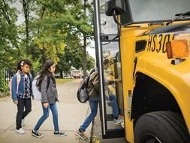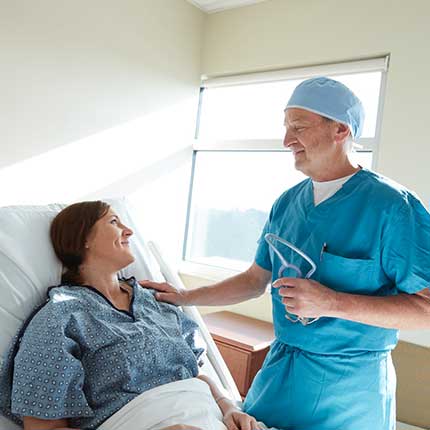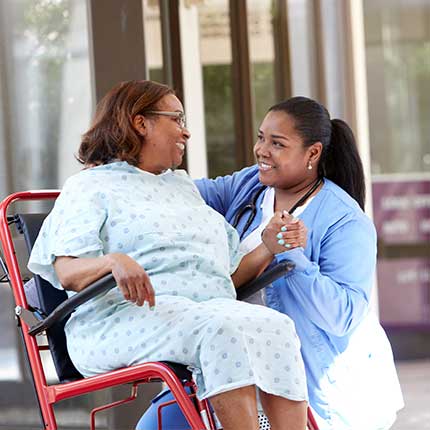Simple lung cancer screening test is easy, painless — and could save your life
Nov 29, 2022Anthony Patterson got lucky — twice.
His first stroke of good fortune came in 2011, when a fall led him to the emergency room of a local hospital. While he was there, doctors noticed his heart wasn’t beating as it should. A pacemaker was implanted, potentially saving his life.
A few years later, when Patterson needed surgery to replace the battery in his pacemaker, a CT scan revealed another problem: a suspicious-looking, quarter-size nodule in his lungs.
“They sent me to Karmanos” Cancer Institute in Detroit, said Patterson, 64, who lives in the New Center area of the city. “They said, ‘Let’s just have some tests done.' They tested it and it came back positive. Cancer.”
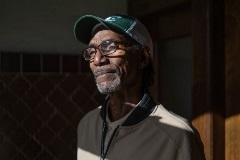
'I'm going under the knife for the C'
The disease was caught at stage 1, before it had spread and early enough to save his life. He had surgery to remove the nodule and didn’t need chemotherapy or radiation.
“I had no clue, no symptoms at all,” said Patterson, a retired security guard who smoked more than 30 years.
“Even the pacemaker didn't make me stop smoking. It did slow me down, but I didn't stop. I was smoking maybe two to four cigarettes a day just to kill the crave, or after dinner. It wasn't a consistent thing.
“But then, when they discovered the lung cancer, that was the last cigarette I had. That wasn’t hard because I made my mind up. I said, ‘You’ve got to put these down. I’m going under the knife for the C.”
Patterson is now more than two years cancer-free and has regular screenings to look for any evidence of recurrence.
“I finally feel like I'm a cancer survivor,” said Patterson, who has six kids and four grandsons. “I feel like that. I do, and I appreciate it. God is good.”
More:Michigan could be pummeled with RSV, flu, COVID-19, health leaders warn
More:RSV cases fill Michigan children's hospitals. At U-M's Mott: 'We're 100% full'
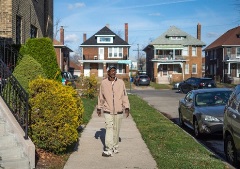
Lung cancer can be cured — if it's caught early
Dr. Lawrence MacDonald wishes for more lung cancer patients with happy endings like Patterson’s.
MacDonald is chief of pulmonary medicine at Huron Valley Sinai Hospital in Commerce Township, and the majority of patients he sees every day don't have prognoses that are as good.
Only about 22% of people diagnosed with lung cancer live beyond the five-year mark, according to the National Cancer Institute. And lung and bronchus cancers kill more people than any other type.
The disease is expected to cause 130,180 U.S. deaths in 2022 — more than double the number of deaths from colorectal cancer, which is second in U.S. cancer deaths.
In the early stages of lung cancer, when it’s most treatable, few people have any symptoms.
“That's why we have to screen for them,” MacDonald said. “Once you come in with symptoms — shortness of breath, cough, coughing up blood, pain in your bones or neurologic symptoms — that often represents cancer that has spread or has grown to the point that it's much more difficult to treat. The whole idea is to catch it before you have symptoms. Don’t wait till you're coughing.”
More:Her grandmother and mother died of lung cancer. Now, she has it, too.
More:Livingston mom battles breast cancer with experimental treatments to help other patients
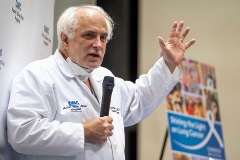
Doctors aim to spot lung cancer at 'toaster fire' phase
People who smoke or have a history of smoking are at highest risk. Others at risk for developing lung cancer include people with significant asbestos exposure and other carcinogens like nickel, chromium and arsenic, as well as exposure to radon, a colorless, odorless gas that naturally occurs in the earth and can get trapped inside buildings. Those with a family history of lung cancer also are more likely to develop it.
Your subscription, your way
Managing your subscription has never been easier. Pause delivery, update your credit card and more online.
Michigan ranks 13th nationally among states with the highest smoking rates, according to the U.S. Centers for Disease Control and Prevention. That makes the state's population more vulnerable.
“The most important prognostic factor for whether or not someone will be a long-term survivor of a lung cancer is whether it can be surgically removed,” said Dr. David Sternberg, an attending cardiothoracic surgeon at Karmanos Cancer Institute, who treated Patterson.
“When you catch a cancer that's stage 1, you're catching something that's early on. You're catching it at the toaster fire stage. When you tell someone, ‘I had a toaster fire in my kitchen,’ the implication is it was something that was concerning but something that was pretty easily dealt with. You take your toaster, you put the fire out and you toss it in the garbage. But on the other hand, a house fire is a totally different problem. We want to catch the lung cancer at the toaster fire stage, before it becomes the house fire.”
But in the U.S., less than 7% of people who are eligible for lung cancer screenings are getting tested, MacDonald said.
The remaining 93% aren’t likely to catch their cancers at toaster fire stage, but rather when the flames have spread to the curtains, the furniture, the walls — when they’re threatening to engulf the house in a full-blown inferno.
Low-dose CT scan can make life-or-death difference
If there were a simple, inexpensive, painless test that could slash the risk of dying from the No. 1 cancer killer in the world, why wouldn’t people line up for it?
That’s the question MacDonald asks every day. He founded the Detroit Cancer Screening Initiative, a consortium of physicians in the region working to spread the word that early detection saves lives.

The test is widely available, relatively inexpensive and for the people at highest risk for developing lung cancer — current and former cigarette smokers ages 50 and older — the screening is covered by Medicare, Medicaid and private insurance.
It’s a low-dose CT scan of the chest. And when at-risk people get the test every year, their chances of dying from lung cancer plummets.
"If someone somewhere in the world came up with a test, a pill, an injection, a surgery or radiation that decreased cancer mortality (this much), it would be all over the news. It would be in the paper. It would be on the radio and everybody would be signing up for it," MacDonald said. "Well, here it is. ... This cannot be ignored. It should be trumpeted on billboards and in the news and on the radio."
MacDonald and nearly a dozen other doctors from Karmanos Cancer Institute, the Detroit Medical Center, Henry Ford Health, Ascension Michigan and others are coming together to improve rates of lung cancer screening by working to educate primary care physicians about the need to prescribe it for patients who qualify.
They’re going out into communities, making contact with church leaders and at local health centers to spread the word about screening. They’re hosting lectures and mailing out flyers as part of their lifesaving campaign.
On Thursday, MacDonald quite literally shone a light on lung cancer, holding a flashlight with dozens of medical providers, patients and their loved ones at the DMC’s Charach Cancer Treatment Center in Commerce Township at an event to raise awareness.
More:U-M study: Manufacturing jobs associated with higher risk of ALS
More:When Novi man with ALS couldn't feed himself anymore, he built his own feeding robot
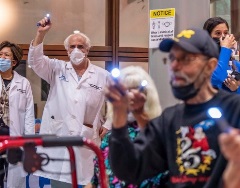
Other doctors who joined the initiative are doing outreach in other ways.
“A lot involves communication," said Dr. John Barnwell, chief of surgery at DMC Sinai Grace Hospital in Detroit. "If I'm in a barbershop, and I started talking about cancer, I can convince them in the barbershop to get it done. You just have to reach out to these individuals.”
Dr. Michael Simoff, a pulmonary and critical care physician at Henry Ford Health, said he is trying to secure funding to pay for a van with a CT scanner inside so his team can bring screening to the places where people live, to areas where smoking rates are high and access to medical care is low.
“The idea would be to take it to people in the urban areas and the rural areas,” Simoff said. “We know that Native Americans have a tremendously high rate of smoking, too, and I’d like to take that at least yearly to see what we can do to help with those populations.”
Who qualifies for lung cancer screening?
The guidelines for who qualifies for lung cancer screening were developed in 2013 by the U.S. Preventive Service Task Force and were updated in 2021 to increase the number of people who are eligible. Now, screening is recommended for anyone ages 50 to 80 years old who:
- Currently smokes and has a 20-pack year history of smoking, which is the equivalent of a pack a day for 20 years or two packs a day for 10 years or
- Quit smoking within the last 15 years but previously had a 20-pack year history of smoking.
Too many people aren't even aware they're eligible, MacDonald said.
A 2021 Prevent Cancer Foundation survey found that two-thirds of Americans weren't getting recommended cancer screenings and one-third weren't even aware of which cancer screenings they needed.
“It's difficult to get people to slow down and take the time to do what they need to do,” said Barnwell, who also serves on the DMC’s governing board. “But you have to spend the time with the patients and convince them that it's well worth it.”
While about 7% of Americans overall who are eligible for lung cancer screening get tested, rates are even lower for African Americans, who MacDonald said, “get screened even less. … They're less likely to get surgery. … They get lung cancer when they’re younger. They get it with smoking fewer cigarettes, too.”
For all those reasons, the mortality rate among Black Americans is higher as well.
More:Michigan lawmaker kept rare cancer private while running for office
More:Oakland County Rep. Andrea Schroeder, 57, dies after battling stomach cancer
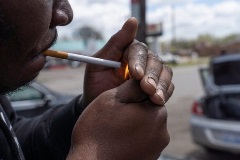
Screening particularly reduces Black mortality
“The disparities are very prevalent, and it's well known,” Barnwell said. “Everybody's trying to figure out how to level the health care field in terms of providing care and it's just, very difficult. ...
“There's so many people who still have so much distrust, and that was very evident with the COVID-19 pandemic. So many people wouldn't get the vaccine. … The African American population still has a hesitancy in terms of getting certain medical care. There's historical validation for some of the concerns and I can understand that.”
Black people in America have been exploited for centuries for medical experimentation, ranging from the Tuskegee Syphilis Study to forced sterilizations.
But, MacDonald said, it’s especially important to reach the Black community with screening.
“As it turns out, interestingly, populations of Black patients probably have more benefit than other patients” with screening, he said. “For some reason, that particular population of people when you screen them, versus not screening them, they have a better mortality benefit than other populations.”
That benefit could be as high as a 26% improvement in the mortality rate, he said.
Poverty, guilt, shame play into lack of screening
Poverty plays a part, too, in low screening rates for lung cancer.
A low-dose CT scan for lung cancer screening costs about $260 without insurance at Huron Valley Sinai Hospital. That cost can be insurmountable for someone who’s uninsured and living in poverty.
“Poor or indigent people just don't have means, necessarily, to get to the doctor, to get access, and many of them are uninsured,” Barnwell said. “They are able to become insured, but it takes time. You have to know the process to do that.”
Dr. Hirva Mamdani, a thoracic medical oncologist who leads a multidisciplinary program at Karmanos, added that people living in poverty also may not have established primary care physicians.
“I can't tell you how many times I see lung cancer patients when they first go to an emergency room because they don't have a primary care physician and now they're short of breath and there is a huge lung tumor," she said. “I think we’ve got to come up with strategies to reach to those people who just simply don't access the health care that frequently.”
People who are still smoking cigarettes might also avoid lung cancer screening because they feel guilt or shame, and might not want to be told they should quit, Simoff said.
“Our goal is to educate, and to say that you should be stopping smoking … because of the risk,” he said. "It’s so important for people to understand we don't think you're bad because you smoke. We think that you have a habit. You've gotten an addiction to something and now how can we provide you resources to help you get away from that.”
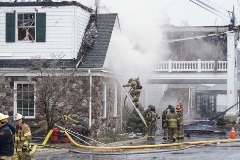
Firefighters left out of recommendations
Social stigma and fear also are rolled into the hesitancy to get lung cancer screening for some people, said Mamdani, who also is the director of the lung cancer screening program at Karmanos.
“There is fear involved with any type of screening,” she said. “Like what if there is something there? It's an I-don't-want-to-find-out type of thing.”
But there is one universal motivator that seems to push people to seek screening, she said.
“People who have a family member diagnosed with some type of a cancer — it doesn't have to be lung cancer, but any kind of cancer — are more likely to be willing to get screened for different types of cancer if they meet the criteria.”
Mamdani worries, too, about the people who don’t meet the eligibility criteria for lung cancer screening, but who still are at high risk for developing the disease.
“For example, somebody who has 18-pack years of smoking history, but they also worked in an industry where there's high exposure to asbestos,” she said. “We know that asbestos and smoking multiply the risk for development of lung cancer as well as mesothelioma. So those patients should have access to lung cancer screening, but they don't because the current guidelines don't include those nuances,” she said.
Firefighters are often left out as well.
“Firefighters are at really high risk of developing lung cancer,” she said, because of on-the-job smoke inhalation. “We have seen it with first responders to 9/11. In fact, I had a patient who was a never smoker. He was … (at) the site of 9/11 in New York and 10 years later, he developed lung cancer and he actually recently passed.
“There has to be an increase in awareness and I think a movement to drive the government agencies and insurance companies to cover lung cancer screening scans for our firefighters.”
Repetition is key to successful screening
Lung cancer screening also can’t be a one-and-done kind of thing, Mamdani said.
“It has to be annual so if there is any abnormality that is detected on the previous scan, that can be followed up,” she said. “Sometimes, you don't see anything on the first one.
“Oftentimes, what happens is people get their first scan and then there is no follow-up. That could be because of personal factors. They don't want to be screened anymore. It provokes anxiety. Their insurance didn't cover the first one or they were kind of stuck with a bill, things like that. Or it could be another problem, which is that they get one scan but then nobody calls to schedule another scan or calls about a follow-up.”
She’s working to ensure that patients are enrolled in a structured program so nothing gets missed.
“A program is important because when we do CT (scan) of the chest, it's not only that we're looking at lungs. We also look at the heart, blood vessels and there can be some abnormalities in those areas like coronary artery disease, aortic aneurysm, those kinds of things,” Mamdani said.
“There can be COPD (chronic obstructive pulmonary disease) or emphysema in the lungs that needs further follow-up.”
Oakland County man quits smoking after cancer scare
It’s that kind of program that Timothy Day, 75, of Farmington Hills, hopes will add years to his life.
He remembers sneaking cigarettes from his mother’s pack as a kid, puffing on them from behind the bushes. It wasn’t until he enlisted in the Army at age 18 that he became a regular smoker.
“I continued smoking right up until about a year or two ago,” he said. “I had been trying to quit off and on.”
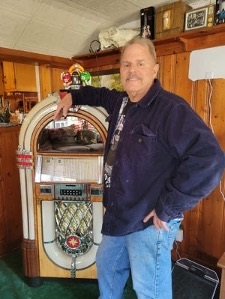
Nicoderm patches helped him quit, said Day, who worked for DTE in metal fabrication and welding for substations until he retired.
It was a health scare that really pushed him to give up cigarettes.
MacDonald recommended a lung cancer screening test.
“He says, ‘You’ve got a couple of nodules here and there and you've got COPD.’ And then my heart doctor said, ‘You better quit smoking or you're not gonna live. You are not going to live.’
“With those two combined, especially with Dr. MacDonald, I just said, ‘I'm done.’ ”
Those nodules weren’t cancerous, but Day plans to go back annually for rechecks. That's because there’s too much for him to live for: his daughter, his grandkids, his cat and his friends.
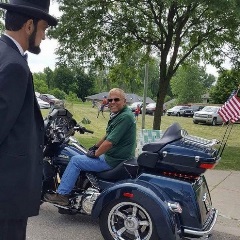
“I have a motorcycle,” he said. “I ride that in the summertime and I belong to a motorcycle group, too. We go on trips — dessert rides and dinner rides — and meet we meet once a month at a restaurant or something like that.
“In the wintertime, I just kind of relax a little bit and blow snow and all that Michigan stuff. I'm just trying to enjoy life and have fun while I can.”
Contact Kristen Jordan Shamus: [email protected]. Follow her on Twitter @kristenshamus. Subscribe to the Free Press.
Original Story here: https://www.freep.com/story/news/health/2022/11/21/lung-cancer-screening-guidelines-2022-eligible/69662857007/

